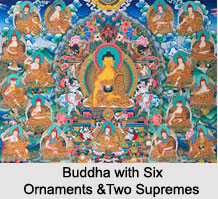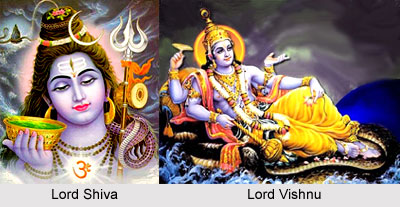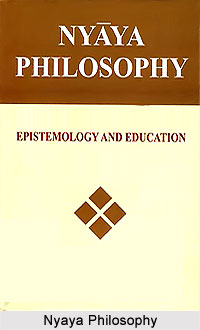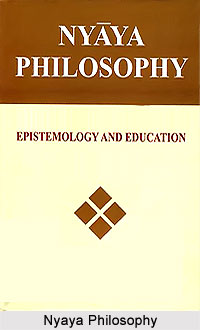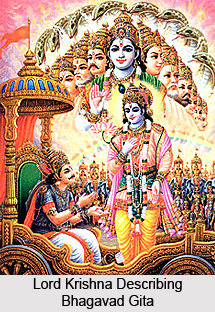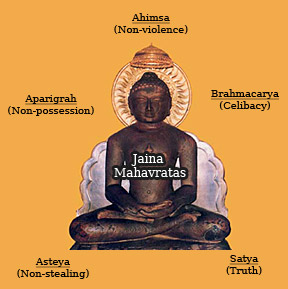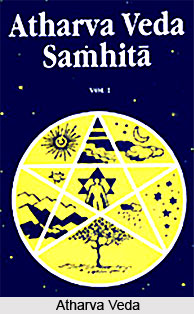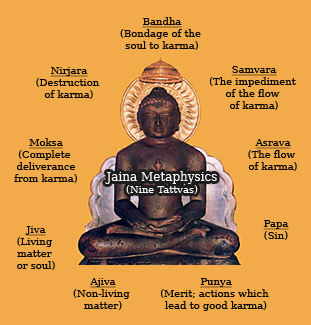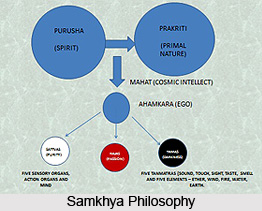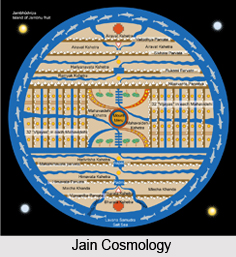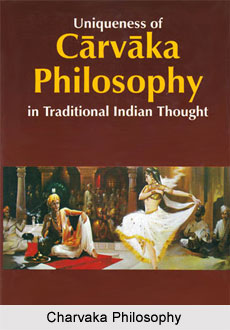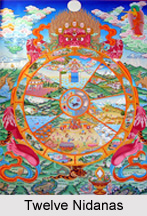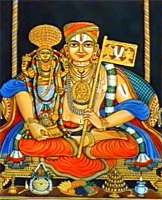Karma-matter requires that the one striving for Nirvana hinders not only the influx of new karma by his behaviour, but also sheds off the Karma which remains. This intentional shedding off of Karma which is bound earlier is called Sakama-nirjani. But it is necessary to say a few words on the nature of the shedding off of Karma so that this concept which is so important for the Jaina-doctrine of salvation could be understood.
Jain Philosophy states that each Karma is produced once, i.e. it attains the condition of "Vipaka" (maturity) like a fruit coming out once from a grain of a seed. Once the Karma has shown its effect, it disappears, and it does not exist any more like a fruit that is eaten. Thus a condition should finally appear in the natural course of things for a man who makes it impossible for new Karma to flow into his soul. In this condition, all the Karma that is stored by him is used up, and his soul becomes free from all Karma. But this condition cannot appear in reality because a man has within his soul so much karma from his numerous existences that it would be exhausted only after a long time, particularly became many Karmas preserve their power for a very long time. It is, therefore, necessary that the annihilation of Karma is, accelerated in an artificial way.
Asceticism besides the observance of precepts which serve to avert Karma causes quick annihilation of Karma. But if this annihilation should really lead to salvation, then it is necessary that it is done in the right manner.
Asceticism is twofold: outer and inner:
An outer asceticism (Bahya-tapas) is of the following six types:
1. Fishing (Anasana).
2. Reduction in food (Avamaudarya) in which only a part of the meal is taken instead of full meal.
3. Reduction in food (Vritti-sariksepa) not only according to the number of meals, but according to the place from where they are received, and according to the time when they are taken and according to the circumstances in which they were taken, etc.
4. Restriction of tasty food (rasa-parityaga) like milk, sugar and other things which taste particularly well.
5. Avoidance of everything that could lead the senses into temptation (Samalinata), above all by precaution that froms the other sex are not in the proximity of the bed.
6. Mortification of flesh (Kaya-klesa) by meditating in great heat or cold, etc., by renouncing every care of the body
It can be said from the preceding that the external asceticism of Jainas consists in enduring the difficulties of all sorts. A jaina-ascetic takes all sorts of pains and discomforts upon him without balking at them. Jainas have rejected the practice of the Brahmanic penitents of giving one artificial pains, like lying on a bed of thorns, etc.
B. Internal asceticism (Abhyantara-tapas) is, also of 6 types:
1. Confession (Prayascitta) made before a Guru or Sadhu.
2. Reverence (Vinaya) which is shown to the servent of the religion.
3. Zeal (Vaiyavrttya) which is shown to masters and teachers, to monks, to the community, laymen and the sick, etc.
4. Study (Swadhyaya).
5. Indifference (Utsarga) with respect to the body and its passions and temptations coming from outside. This complete disrespect of everything that does not belong to the soul is expressed most excellently in the complete negligence of everything that is corporeal, which leads to voluntary death by starvation.
6. Meditation (Dhyana), i.e "fixation and concentration of thought for a Muhurta, i.e. at the most for 48 minutes. These 48 minutes represent the maximum of what can be achieved. Meditation can be taken up only by the one who has the best dispensation of articulation (of joints). On the whole, four types of meditation are distinguished, however, only the last two of these are suitable to lead one to salvation.
(1) Arta-dhyana, melancholy meditation, Arta- dhyana is constant ruminating about something that is unpleasant that one has experienced. Of these 4 types are distinguished:
(a) Ista-viyoga, thinking of something pleasant one has lost.
(b) Anista-samyoga, thinking of something unpleasant one has experienced.
(c) Roga-chinta, thinking of illness.
(d) Nidanartha, thinking of the future, particularly of the wishes which should be realized in a later existence.
(2) Raudra-dhyana, bad meditation, is directed towards worldly goals, viz. murder, lie, theft and preserving goods.
These types of meditation are found among beings up to the 5th Gunasthana.
Both the following meditations promote salvation in contest to the first two.
(3) Dharma-dhyana, meditation consisting in thinking of religion. It is directed towards:
(a) Ajna-vichaya, the holy doctrine.
(b) Vichaya, the fact that the soul is obstructed in the devolopment of its true nature by something that does not belong to it.
(c) Vipaka-Vichaya, consequences of the Karma that have befallen the soul.
(d) Samsthana-vicaya is focussed on the structure and the nature of universe. This meditation is found in the gunasthanas 7 to 12.
(4) Sukla-dhyana, pure meditation. Of this, 4 stages are distinguished:
(a) Prithakitva-vitarka is directed towards the conduct and the contradictions in the process of the world
(b) Ekatva- vitarka is directed towards the soul as the one which stains all changes.
(c) Suksma-kriya-pratipati is directed towards suppressing the activity which still exists in minimal degree.
(d) Uparata- kriyanivrtti is focussed on complete liberation Karmas.
The four stages of "pure meditation" follow one alter the other; the first falls in the Gunasthanas 8 to the second in 12, the third in 13,the last comes in the 14th directly before redemption.



